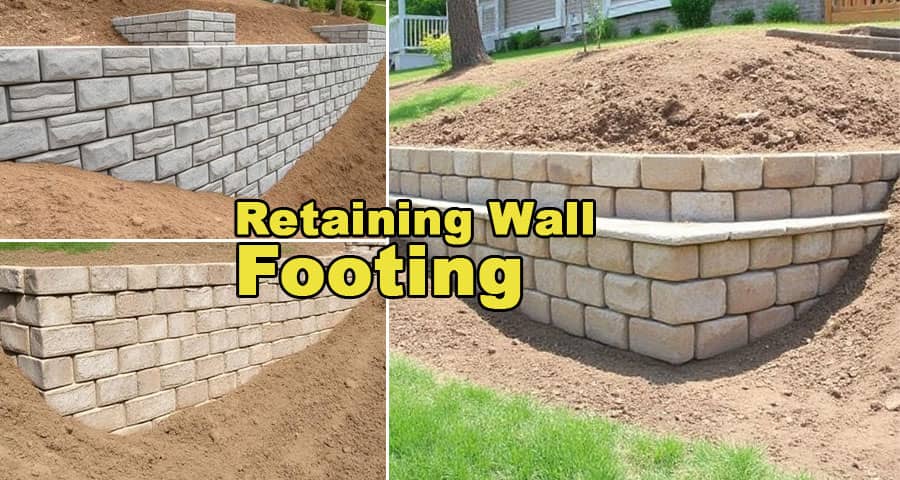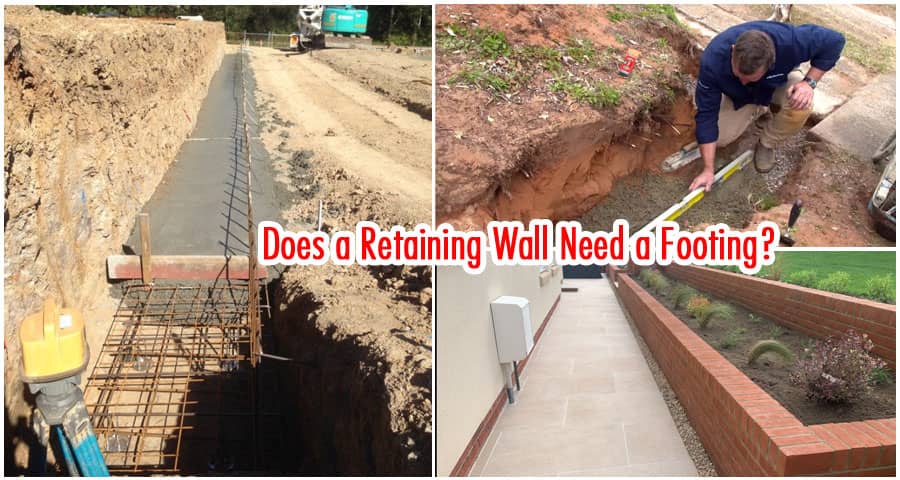Does a Retaining Wall Need a Footing?

Retaining walls are important structures designed to hold back soil or other materials to prevent erosion and maintain the stability of landscapes. When constructing a retaining wall, one crucial consideration is whether it needs a footing.
Introduction
Retaining walls serve a vital role in landscaping and civil engineering projects. They provide structural support and prevent the movement of soil, especially in areas with significant grade changes. A retaining wall must be designed and constructed carefully to ensure its effectiveness and longevity. One key aspect to consider during the construction process is the use of footings.
Understanding Retaining Walls
Retaining walls are vertical or near-vertical structures that hold back soil or other materials. They are commonly used in areas where there are elevation differences or slopes, preventing erosion and maintaining the integrity of the landscape. These walls can be built using various materials, such as concrete, stone, wood, or even reinforced soil.
The Purpose of a Footing
A footing, also known as a foundation, is an essential component of many structures, including retaining walls. It is the part of the wall that spreads the weight of the wall and the load it carries over a larger area of the ground. The primary purpose of a footing in a retaining wall is to provide stability and prevent the wall from settling or shifting over time.
Do All Retaining Walls Require Footings?
The need for a footing in a retaining wall depends on various factors, including the height of the wall, the type of soil, and the slope's angle. In general, shorter walls with stable soil conditions may not require a footing. However, taller walls or those built on less stable soil will almost always require a footing to ensure stability and prevent failure.
Factors Affecting the Need for a Footing
Several factors influence the requirement for a footing in a retaining wall. These include:
- Height of the Wall : Taller retaining walls exert more pressure on the soil and are more prone to instability. As the height increases, the need for a footing becomes more critical to distribute the load and prevent potential failure.
- Soil Conditions: The type and quality of the soil play a significant role in determining whether a footing is necessary. Cohesive soils, such as clay or silt, may require a footing due to their lower stability compared to granular soils like sand or gravel.
- Slope Angle: The slope angle of the land where the retaining wall is constructed affects the forces acting on the wall. Steeper slopes generate greater pressure, necessitating the use of a footing to counteract the added force.
Types of Footings for Retaining Walls
Several types of footings are commonly used in retaining wall construction. The choice of footing depends on factors such as the wall's height, soil conditions, and engineering recommendations. Some common types of footings include:
- Trench Footings: Trench footings are shallow footings that spread the load horizontally. They are suitable for shorter retaining walls or walls built on stable soil conditions.
- Strip Footings: Strip footings are wider footings that distribute the weight of the wall over a larger area. They are often used for taller retaining walls or walls built on less stable soil.
- Reinforced Concrete Footings: Reinforced concrete footings provide additional strength and stability to retaining walls. They are designed with reinforcing steel bars to withstand higher loads and prevent cracking or failure.
Construction Guidelines for Retaining Wall Footings
To ensure the proper construction of retaining wall footings, certain guidelines should be followed:
- Consult with a qualified engineer or structural designer to determine the appropriate footing type and dimensions for your specific project.
- Excavate the trench or area where the footing will be placed, ensuring it is deep enough and has a stable base.
- Install any required reinforcement, such as steel bars, as per the engineering specifications.
- Pour the footing concrete, making sure it is adequately compacted and leveled.
- Allow sufficient curing time before proceeding with the construction of the retaining wall.

Importance of Professional Design and Engineering
Designing and constructing a retaining wall, including its footing, requires expertise in structural engineering and geotechnical considerations. Professional designers and engineers have the knowledge and experience to assess the site conditions, calculate loads, and determine the most suitable footing design. Engaging professionals ensures the safety, stability, and compliance of the retaining wall.
Common Mistakes to Avoid
When building a retaining wall with a footing, it is crucial to avoid common mistakes that can compromise the wall's integrity. Some common mistakes include:
- Inadequate footing dimensions or improper reinforcement placement.
- Failure to consider soil conditions and slope stability during the design phase.
- Improper compaction of the soil beneath the footing, leading to settlement.
- Neglecting to obtain the necessary permits or approvals before construction.
Benefits of Using Footings in Retaining Walls
Incorporating footings in retaining walls offers several advantages:
- Enhanced stability: Footings distribute the weight of the wall and its load over a larger area, minimizing the risk of settlement or failure.
- Increased durability: Properly designed and constructed footings provide long-term structural integrity, ensuring the retaining wall withstands the test of time.
- Improved safety: A stable retaining wall reduces the chances of collapse or slope failure, promoting safety for nearby structures and individuals.
- Design flexibility: With the right footing design, various types of retaining walls can be constructed to suit specific aesthetic and functional requirements.
Ensuring Longevity and Stability
To maximize the longevity and stability of a retaining wall with a footing, regular maintenance and inspections are essential. Periodically check for signs of settlement, cracks, or soil erosion near the wall. Proper drainage should also be ensured to prevent water accumulation, which can compromise the integrity of the wall. Prompt repairs and necessary reinforcements should be undertaken as soon as any issues are detected.
Maintenance and Inspection
Maintaining a retaining wall with a footing involves:
- Regularly inspecting the wall for any signs of damage, such as cracks or bulges.
- Checking the drainage system to ensure proper water flow and prevention of water accumulation.
- Removing any vegetation or debris that may affect the stability of the wall.
- Conducting repairs or reinforcements promptly to address any identified issues.
Conclusion
In conclusion, the use of a footing in a retaining wall is essential for ensuring stability, longevity, and safety. While not all retaining walls require footings, factors such as height, soil conditions, and slope angle play a significant role in determining their necessity. Consulting with professionals and following proper construction guidelines are crucial steps in building a retaining wall that effectively serves its intended purpose.
please watch the following short video for Retaining Wall Need a Footing
FAQs
Do all retaining walls need footings?
Not all retaining walls require footings. The need for a footing depends on factors such as wall height, soil conditions, and slope angle. Taller walls and those built on less stable soil generally require footings for added stability.
What happens if a retaining wall doesn't have a footing?
A retaining wall without a footing may experience settlement, leaning, or failure over time. Footings help distribute the weight of the wall and its load, preventing excessive pressure on the soil and ensuring long-term stability.
Can I build a retaining wall with a footing myself?
While it is possible to build a retaining wall with a footing as a DIY project, it is highly recommended to consult with a professional engineer or designer. They can assess the site conditions, provide proper design specifications, and ensure compliance with local regulations.
How long does a retaining wall with a footing last?
The lifespan of a retaining wall with a footing depends on various factors, including the quality of construction, materials used, and maintenance practices. With proper design, construction, and maintenance, a well-built retaining wall can last for several decades.
Can footings be added to an existing retaining wall?
Adding footings to an existing retaining wall is challenging and often not feasible without significant modifications. It is best to consult with a professional to assess the feasibility and potential impact on the wall's stability before considering such modifications.
